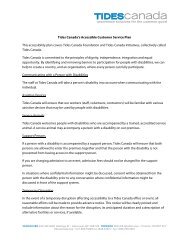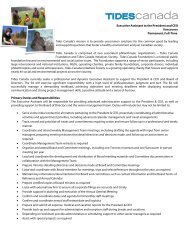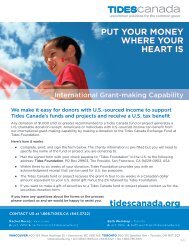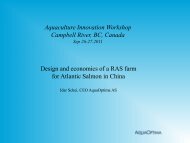Entrepreneurial Solutions to Insoluble Problems - Tides Canada
Entrepreneurial Solutions to Insoluble Problems - Tides Canada
Entrepreneurial Solutions to Insoluble Problems - Tides Canada
- No tags were found...
Create successful ePaper yourself
Turn your PDF publications into a flip-book with our unique Google optimized e-Paper software.
Growing OpportunitySurvey Findings‘We have had a significantincrease in companieswanting <strong>to</strong> sponsor us.The challenge is <strong>to</strong> remainselective and not <strong>to</strong> sell out.’Anonymous respondent54www.landminesblow.com55www.drishtee.com56www.gexsi.org57www.sports4kids.org58www.itnamerica.orgOn the for-profit side, Orb Energy is alsousing the franchising model <strong>to</strong> scale itsoperations in India, preferring this routerather than raising additional capital.The franchise model, based on setting upbranches, enables them <strong>to</strong> get closer <strong>to</strong>cus<strong>to</strong>mers, while establishing a common‘look and feel’ and affording greatereconomies of scale. A key challenge inthis approach, CEO Damian Miller notes,is <strong>to</strong> ensure that franchisees do notsacrifice quality for revenues.Joint venturesAround a third (30%) of respondentsmentioned joint ventures as a form ofresourcing — and it was clear that a fairfew entrepreneurs plan <strong>to</strong> develop suchpartnerships, though a surprising numberexpressed anxiety about their ability <strong>to</strong>identify suitable partners and strike abalanced deal. That said, they all felt theyhad significant value <strong>to</strong> add. And thosetaking this route saw many non-financialbenefits. Such partnerships, said LandminesBlow!, 54 help both parties ‘leverage theirassets, such as their expertise and clientbase, with other advantages includingsharing knowledge, the cultivation of newrelationships, developing a continuum ofcare, working successfully in differentcultural settings, and [gaining] approvalfrom the United States Federal Governmentand the United Nations.’Optimistically, perhaps, the vision is that,‘In a new world of virtual integration,the walls between enterprises crumble.’It is clear that those thinking aboutthis option are concerned about theimplications. ‘We have had a significantincrease in companies wanting <strong>to</strong> sponsorus,’ said one, who asked <strong>to</strong> remainanonymous. ‘The challenge is <strong>to</strong> remainselective and not <strong>to</strong> sell out. To maintainthe purity of our program.’ The need <strong>to</strong>find out how <strong>to</strong> do such due diligencewas an issue often raised.Venture capitalOne respondent described his challengeas, ‘raising money for ideas that othershave not accepted as workable.’ Oneway the mainstream economy dealswith this challenge is via venture capital.Surprisingly, this came in fifth place, withmore than a third (39%) of respondentssaying they plan <strong>to</strong> draw <strong>to</strong> some exten<strong>to</strong>n venture funding. If true, this is a strikingresult, though it may reflect the inclusionof a number of cleantech entrepreneursin our sample and, possibly also, a misunderstandingon the part of at least somesocial entrepreneurs of what venturecapital funding entails.One respondent even spoke of ‘venturecapital gifts.’21More typically, Drishtee 55 — whichaims <strong>to</strong> empower entrepreneurs in India,village-by-village — spoke for many socialentrepreneurs in saying that they look, inall areas of funding, for ‘sources of fundsthat look for a commercial and social returnon investment (ROI), simultaneously.’ Theproblem with the venture capital field, asnormally unders<strong>to</strong>od, is that considerationsabout social ROI are likely <strong>to</strong> be even moresqueezed than in the financial mainstream.IPOs and market listingsThis was very much bot<strong>to</strong>m of the heap,coming in tenth place (2%) — and witha degree of unease about the implicationsand constraints expressed by a couple ofthe entrepreneurs we interviewed in depth.The relatively slow progress of initiativeslike the Global Exchange for SocialInvestment (GEXSI) 56 hasn’t helped.As John Wood, Founder and CEO of Room<strong>to</strong> Read put it, ‘The capital markets forNGOs are blatantly inefficient. There isno mechanism that has the efficiency ofthe private sec<strong>to</strong>r (e.g. NYSE, NASDAQ,private placements, venture capital) whenit comes <strong>to</strong> raising large amounts of capital— especially unrestricted funding. This,of course, is one reason why SASE (SkollAwards for Social Entrepreneurship)recipients are so grateful for the large,unrestricted, multi-year funding. The NGOworld needs <strong>to</strong> have every large foundationseriously study — and hopefully emulate —this model.’ And what is true for NGOs isalso true for most social enterprises.‘Other’ sourcesThis category was selected by 17% ofrespondents. The main additional sourceof funding identified was corporatepartnerships or sponsorship, althoughthat could potentially wrap in under ’Salesand Fees’ or ‘Joint Ventures’. Most suited<strong>to</strong> this option are enterprises that addressissues of interest <strong>to</strong> high-brand companies.Take Sports4Kids, 57 which argued that,‘because of our emphasis on youth andsports, we are uniquely well-positioned <strong>to</strong>establish significant corporate partnershipswith a range of industries, includingfootwear/apparel, food, and professionalsports.’ Another enterprise, ITNAmerica, 58which focuses on dignified transportationfor seniors,’ noted that corporatesponsorship ‘is our riskiest revenue stream— but we feel it has great promise, as werepresent a large and growing market.’
















